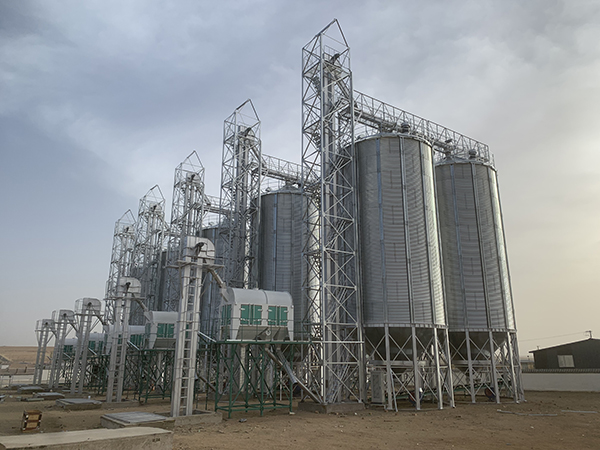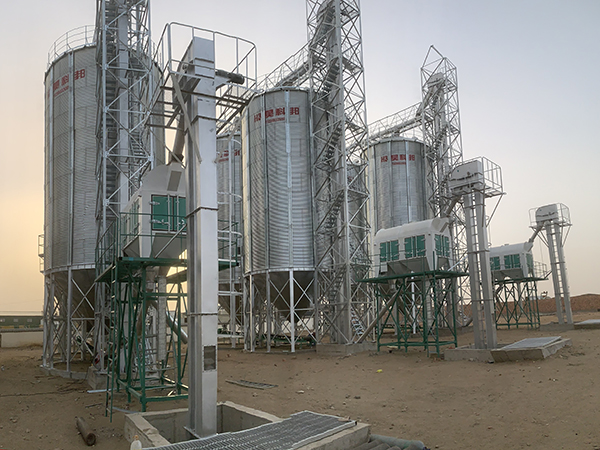Hopper Bottom Silo
hopper bottom silo, commonly known as a conical bottom silo or hopper bottom silo, is a specially designed storage silo with one or more conical
Hopper Bottom Silo Introduction
A hopper bottom silo, commonly known as a conical bottom silo or hopper bottom silo, is a specially designed storage silo with one or more conical or hopper-shaped structures at the bottom to facilitate the flow of materials and reduce the risk of clogging. This design is particularly useful for storing bulk materials that are prone to agglomeration or have poor flow characteristics, such as certain types of grains, feedstuffs, and chemical raw materials.


Features of hopper bottom silo
Hopper Design
The bottom is shaped into a hopper, which aids in the gravitational flow of materials.
Promotes Flow
The hopper shape reduces dead zones in material storage, facilitating even flow and reducing the dwell time of materials.
Reduces Clogging
The hopper bottom design minimizes blockages caused by moisture, agglomeration, or other reasons.
Ease of Discharge
Materials can be smoothly discharged from the hopper’s outlet or discharge valve, facilitating automated and mechanized operations.
Structural Stability
espite the hopper shaped bottom, the entire silos must maintain adequate stability and strength.
Easy to Clean and Maintain
The hopper bottom design makes cleaning and maintenance relatively easy, helping to keep the stored materials hygienic and of high quality.
Adaptability
Suitable for storing a variety of materials, especially those that require special attention to flow and clogging issues.
Improves Efficiency
By optimizing material flow, hopper bottom silo can enhance the efficiency of the entire material handling and supply chain processes.


Hopper bottom silo structure
Silo Body
This is the vertical or inclined part of the silo that contains and stores the material.
Roof Structure
Includes components that cover the top of the silo, which may feature vents, manhole covers, and other structures necessary for maintenance and operation.
Walls
The sidewalls of the silo, typically made of corrosion- and wear-resistant materials to protect the silo from erosion by the stored material.
Hopper Bottom
The distinctive feature of a hopper-bottom silo, with the bottom designed in a conical or hopper shape to facilitate material flow and reduce clogging.
Discharge Outlet
Located at the lowest point of the hopper bottom, used for releasing the stored material.
Ventilation System
Comprises natural or mechanical ventilation equipment to control the internal temperature and humidity of the silo, preventing the material from becoming damp or spoiling.
Inlet and Outlet System
Comprises conveying equipment for filling the silo with material and a system for discharging material from the silo.
Support Structure
Supports the entire silo, ensuring its stability.
Foundation
The supporting part of the silo, typically made of concrete or other stable materials to ensure the silo’s stability and durability.


Advantages of hopper bottom silo
Good flowability
The design at the bottom of the hopper facilitates better material flow, reducing the likelihood of adhesion and blockages, common issues with sticky or adhesive materials.
Efficient discharge
Thanks to the sloped bottom of the hopper, materials can be discharged more efficiently and completely.
Space-saving
Compared to flat bottom silos, hopper bottom silo are more compact, occupying less space, making them a space-saving storage solution.
Ease of management and maintenance
The simple structure of the silo makes it relatively easy to clean, maintain, and manage, allowing operators to monitor and maintain it more easily.
Improved production efficiency
Hopper bottom silo can help streamline the production process, reducing material handling time and costs, thereby improving production efficiency.
Versatility
They can be used for various bulk materials, not only in agriculture but also in industries such as chemical, food processing, and mining.
Cost-effectiveness
While the initial construction costs may be higher due to the complexity of the bottom design, the benefits of reduced maintenance and improved efficiency can make hopper bottom silo a cost-effective solution in the long run.
Scalability
The size and capacity of hopper bottom silo can be expanded according to storage needs, allowing for flexibility in operations.
Application scope of Hopper bottom silo
Coban Silo is widely used for grain storage such as wheat, corn, soybean, paddy, rice, soybean meal, barley, malt, sunflower seeds, rapeseed, peanuts, flour, and other powder materials, oat, special Silo, and seeds, etc. Steel silo products include 100 ton, 300 ton, 500 ton, 1000 ton, 2000 ton, 3000 ton, 5000 ton and 10000 ton steel silo as well as metal silo, spiral silo and galvanized silo.

Hopper bottom silo technical parameters
Scientifically speaking, the Silo capacity should be measured with volume (m3). Even in the same grain Silo, the storage tons will be different for different grains with different densities. The following table is calculated based on a Silo density of 0.75kg/m3, and surely HKB customizes Silo systems unique for you.
| Most Popular Hopper Bottom Steel Silo Technical Specifications | ||||||||
| Capacity | 50Ton | 100Ton | 150Ton | 200Ton | 300Ton | 500Ton | 1000Ton | 1500Ton |
| Model | TCZK
03605 |
TCZK
04507 |
TCZK
05507 |
TCZK
06406 |
TCZK
07307 |
TCZK
07313 |
TCZK
11010 |
TCZK
12811 |
| Diameter(m) | 3.667 | 4.584 | 5.500 | 6.417 | 7.334 | 7.334 | 11.000 | 12.834 |
| Total Height(m) | 9.56 | 12.53 | 13.25 | 12.85 | 14.70 | 21.42 | 20.95 | 23.51 |
| Volume(m³)
Density:0.75ton/m³ |
69 | 150 | 222 | 273 | 415 | 699 | 1346 | 2039 |
| Most Popular Flat Bottom Steel Silo Technical Specifications | ||||||||
| Capacity | 1000Ton | 1500Ton | 2000Ton | 2500Ton | 3000Ton | 5000Ton | 8000Ton | 10000Ton |
| Model | TCK
10014 |
TCK
11915 |
TCK
13715 |
TCK
15514 |
TCK
15518 |
TCK
18321 |
TCK
24718 |
TCK
25621 |
| Diameter(m) | 10.084 | 11.918 | 13.750 | 15.584 | 15.584 | 18.334 | 24.751 | 25.668 |
| Total Height(m) | 18.69 | 20.34 | 20.87 | 20.30 | 24.78 | 28.60 | 26.99 | 30.60 |
| Volume(m³)
Density: 0.75ton/m³ |
1335 | 2009 | 2701 | 2467 | 4145 | 6693 | 10879 | 13484 |








